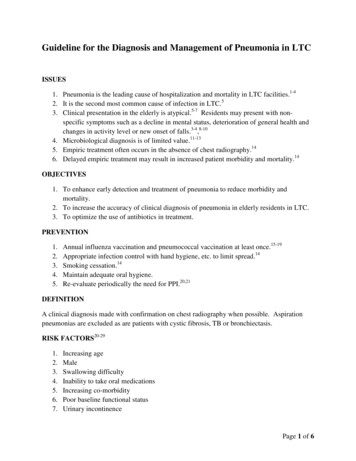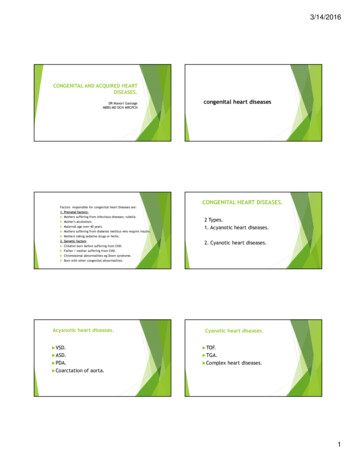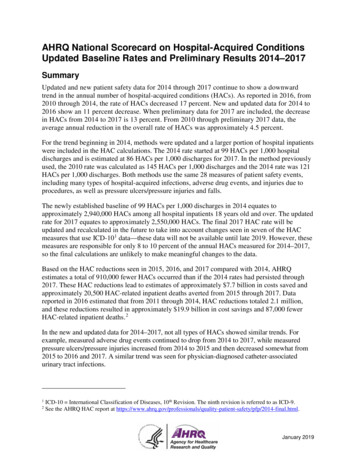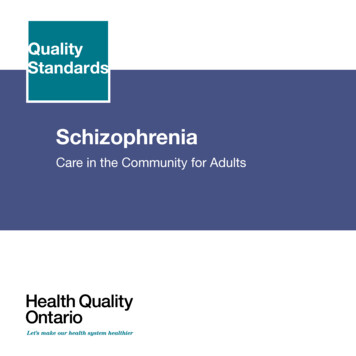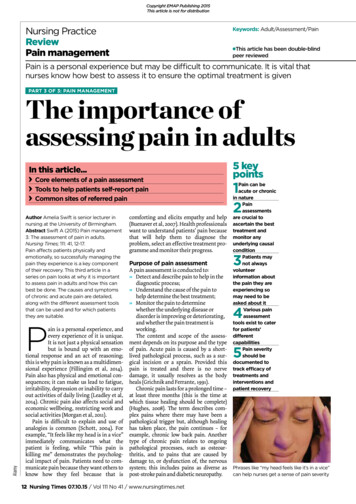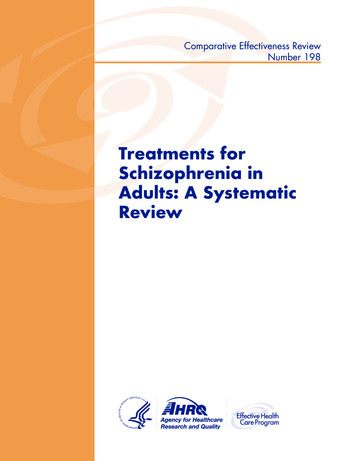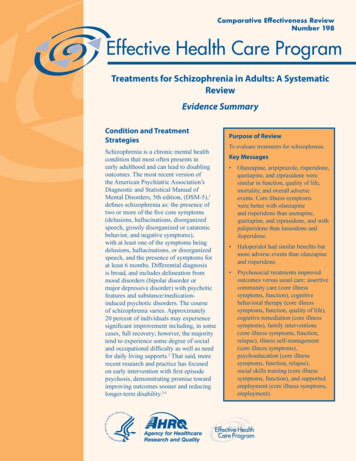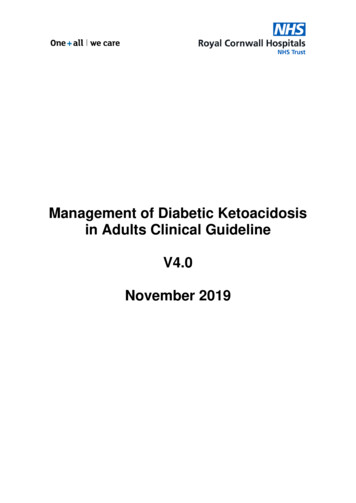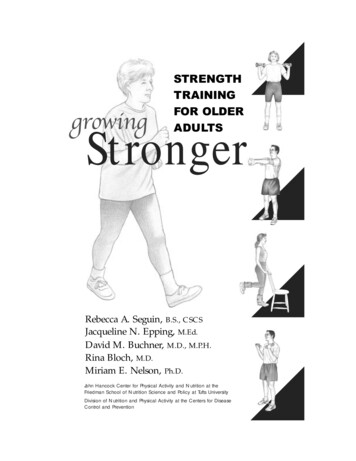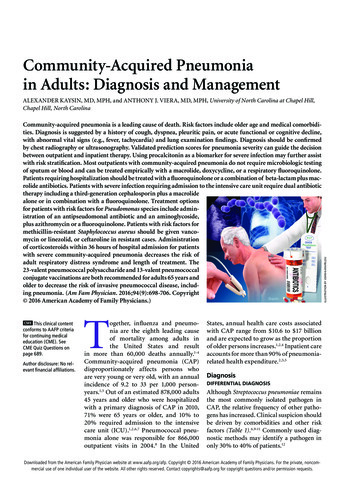
Transcription
Community-Acquired Pneumoniain Adults: Diagnosis and ManagementCommunity-acquired pneumonia is a leading cause of death. Risk factors include older age and medical comorbidities. Diagnosis is suggested by a history of cough, dyspnea, pleuritic pain, or acute functional or cognitive decline,with abnormal vital signs (e.g., fever, tachycardia) and lung examination findings. Diagnosis should be confirmedby chest radiography or ultrasonography. Validated prediction scores for pneumonia severity can guide the decisionbetween outpatient and inpatient therapy. Using procalcitonin as a biomarker for severe infection may further assistwith risk stratification. Most outpatients with community-acquired pneumonia do not require microbiologic testingof sputum or blood and can be treated empirically with a macrolide, doxycycline, or a respiratory fluoroquinolone.Patients requiring hospitalization should be treated with a fluoroquinolone or a combination of beta-lactam plus macrolide antibiotics. Patients with severe infection requiring admission to the intensive care unit require dual antibiotictherapy including a third-generation cephalosporin plus a macrolidealone or in combination with a fluoroquinolone. Treatment optionsfor patients with risk factors for Pseudomonas species include administration of an antipseudomonal antibiotic and an aminoglycoside,plus azithromycin or a fluoroquinolone. Patients with risk factors formethicillin-resistant Staphylococcus aureus should be given vancomycin or linezolid, or ceftaroline in resistant cases. Administrationof corticosteroids within 36 hours of hospital admission for patientswith severe community-acquired pneumonia decreases the risk ofadult respiratory distress syndrome and length of treatment. The23-valent pneumococcal polysaccharide and 13-valent pneumococcalconjugate vaccinations are both recommended for adults 65 years andolder to decrease the risk of invasive pneumococcal disease, including pneumonia. (Am Fam Physician. 2016;94(9):698-706. Copyright 2016 American Academy of Family Physicians.)CME This clinical contentconforms to AAFP criteriafor continuing medicaleducation (CME). SeeCME Quiz Questions onpage 689.Author disclosure: No relevant financial affiliations.Together, influenza and pneumonia are the eighth leading causeof mortality among adults inthe United States and resultin more than 60,000 deaths annually.1-4Community-acquired pneumonia (CAP)disproportionately affects persons whoare very young or very old, with an annualincidence of 9.2 to 33 per 1,000 personyears.1,5 Out of an estimated 878,000 adults45 years and older who were hospitalizedwith a primary diagnosis of CAP in 2010,71% were 65 years or older, and 10% to20% required admission to the intensivecare unit (ICU).1,2,6,7 Pneumococcal pneumonia alone was responsible for 866,000outpatient visits in 2004.8 In the UnitedStates, annual health care costs associatedwith CAP range from 10.6 to 17 billionand are expected to grow as the proportionof older persons increases.1,2,4 Inpatient careaccounts for more than 90% of pneumoniarelated health expenditure.2,3,5DiagnosisDIFFERENTIAL DIAGNOSISAlthough Streptococcus pneumoniae remainsthe most commonly isolated pathogen inCAP, the relative frequency of other pathogens has increased. Clinical suspicion shouldbe driven by comorbidities and other riskfactors (Table 1).6,9-11 Commonly used diagnostic methods may identify a pathogen inonly 30% to 40% of afpVolume94, Physicians.Number 9For theNovember1, 2016Downloadedfrom theAmericanFamily Physician website at www.aafp.org/afp.Copyright 2016 American Academyof Familyprivate, noncom mercial use of one individual user of the website. All other rights reserved. Contact copyrights@aafp.org for copyright questions and/or permission requests.ILLUSTRATION BY JOHN KARAPELOUALEXANDER KAYSIN, MD, MPH, and ANTHONY J. VIERA, MD, MPH, University of North Carolina at Chapel Hill,Chapel Hill, North Carolina
Community-Acquired PneumoniaSORT: KEY RECOMMENDATIONS FOR PRACTICEEvidenceratingReferencesIn patients with suspected CAP, chest radiography or lung ultrasonography should be performed to confirmthe diagnosis.C6, 13, 17, 18Testing for specific pathogens should be ordered only when it would alter standard empiric therapy, whichis rare in outpatients.C6, 19, 22, 25Use of procalcitonin testing can assist in the management of CAP and reduce antibiotic exposure withoutcompromising patient safety.C27-29Validated mortality and pneumonia severity assessment tools should be used to determine the appropriatelevel of care for patients with CAP.C6, 31, 34Patients with CAP who are admitted to the intensive care unit should be treated with dual antibiotic therapy.B6, 43For patients with severe CAP, use of corticosteroids within 36 hours improves outcomes.A46-48Influenza vaccination for all patients and pneumococcal vaccination for patients 65 years and older andother high-risk patients are the mainstays of CAP prevention.A49-51Clinical recommendationCAP community-acquired pneumonia.A consistent, good-quality patient-oriented evidence; B inconsistent or limited-quality patient-oriented evidence; C consensus, disease-orientedevidence, usual practice, expert opinion, or case series. For information about the SORT evidence rating system, go to http://www.aafp.org/afpsort.Table 1. Risk Factors and Pathogens in Community-Acquired PneumoniaRisk factorRelated pathogensAlcoholismAnaerobic oral flora, Klebsiella pneumoniae, Mycobacterium tuberculosis,Streptococcus pneumoniaeAspirationAnaerobic oral floraBioterrorismBacillus anthracis (anthrax), Francisella tularensis (tularemia), Yersinia pestis (plague)Chronic obstructive pulmonary disease or smokingChlamydophila pneumoniae, Haemophilus influenzae, Legionella species,9,10Moraxella catarrhalis, Pseudomonas aeruginosa or other gram-negative rods,S. pneumoniaeExposure to bat or bird droppingsHistoplasma capsulatumExposure to farm animals or parturient catsCoxiella burnetii (Q fever)HIV infection (early)H. influenzae, M. tuberculosis, S. pneumoniaeHIV infection (late)Aspergillus and Cryptococcus species, H. capsulatum, H. influenzae, Nocardiaspecies, nontuberculous mycobacteria, Pneumocystis jiroveciHotel or cruise ship travel in past two weeksLegionella speciesInfluenza active in communityH. influenzae, influenza and other respiratory viruses, S. pneumoniae,Staphylococcus aureus (including MRSA)Injection drug useAnaerobes, M. tuberculosis, S. aureus (including MRSA), S. pneumoniaeLung abscessAnaerobic oral flora, M. tuberculosis, nontuberculous mycobacteria, S. aureus(including MRSA)Travel to or residence in Middle EastMiddle East respiratory syndromeTravel to or residence in Southeast Asia and East AsiaAvian influenza, severe acute respiratory syndromeTravel to or residence in southeastern and southcentral states bordering the Mississippi and OhioRiver basinsBlastomyces dermatitidisTravel to or residence in southwestern United StatesCoccidioides species, Hantavirus speciesHIV human immunodeficiency virus; MRSA methicillin-resistant Staphylococcus aureus.Adapted with permission from Mandell LA, Wunderink RG, Anzueto A, et al. Infectious Diseases Society of America/American Thoracic Society consensus guidelines on the management of community-acquired pneumonia in adults. Clin Infect Dis. 2007;44(suppl 2):S46, with additional information from references 9 through 11.
Community-Acquired PneumoniaTable 2. Prediction Rule for CommunityAcquired Pneumonia DiagnosisWHAT IS NEW ON THIS TOPIC: COMMUNITYACQUIRED PNEUMONIAFor patients with severe community-acquired pneumonia,corticosteroids decrease the risk of adult respiratory distresssyndrome and modestly reduce intensive care unit and hospitalstays, duration of intravenous antibiotic treatment, and time toclinical stability without increasing major adverse events.Adults 65 years and older should routinely receive the13-valent pneumococcal conjugate vaccine (PCV13; Prevnar13) and the 23-valent pneumococcal polysaccharide vaccine(PPSV23; Pneumovax 23), preferably PCV13 first followed byPPSV23 in 12 months.Add points when presentPointsRhinorrhea–2Sore throat–1Night sweats1Myalgia1Sputum all day1Respiratory rate 25 breaths per minute2Temperature 100 F (37.8 C)2Total:HISTORY AND PHYSICAL EXAMINATIONScoring and likelihood ratios of pneumoniaIMAGINGLung imaging with chest radiography has been thestandard method of diagnosing pneumonia6 (Figure 1).700 American Family PhysicianTotal pointsLikelihood ratio3LR 14.01LR 5.0–1LR 1.5 –1LR– 0.2LR positive likelihood ratio; LR– negative likelihood ratio.Information from reference 14.COPYRIGHT VISUAL DXMost patients with CAP present with a combinationof cough, dyspnea, pleuritic pain, fever or chills, andmalaise. Risk and severity of CAP, including infectionwith less common pathogens (e.g., Legionella species),increase with older age, cardiopulmonary disease, poorbaseline functional status, low socioeconomic status,and recent weight loss or underweight status.4,9 Althougha thorough history is an essential component in the diagnosis of CAP, no individual symptom can adequatelypredict its presence. Across four studies, the most predictive findings were fever greater than 100 F (37.8 C) (positive likelihood ratio [LR ] is approximately 2.7) andegophony (LR 5.3).13 Clinical prediction rules thatcombine symptoms and examination findings (Table 214)can be helpful in generating a likelihood ratio that canbe applied to patients with different prior probabilities ofCAP and aid in diagnosis and management.14Physician judgment has better discriminatory ability to rule out pneumonia (negative likelihood ratio[LR–] 0.25), but ability to clinically diagnose pneumonia is less certain (LR 2.0).13 Patients with no vitalsign abnormality and normal lung examination findingsare unlikely to have pneumonia.15 Thus, lung imaging ishelpful for patients presenting with possible CAP whohave any vital sign or examination abnormalities (giventhe absence of asthma).16Guidelines from the Infectious Diseases Society ofAmerica advise diagnosing CAP based on suggestiveexamination findings and characteristic infiltrate onchest radiography with or without microbiologic data.6Caution should be used when diagnosing CAP in olderpatients and those who are immunocompromisedbecause they may not exhibit typical symptoms suchas a fever greater than 100.4 F (38 C). However, mostpatients exhibit at least one respiratory symptom; acutefunctional or cognitive decline; or repeat temperaturesof 99 F (37.2 C) or greater.15Figure 1. Chest radiograph showing right middle lobeinfiltrate in a patient with pneumonia.Lung ultrasonography has the potential to more accurately and efficiently diagnose pneumonia, as well aspleural effusions, pneumothorax, pulmonary embolism,and pulmonary contusions.17 Two recent meta-analysesusing chest computed tomography as the comparativestandard show that lung ultrasonography has a pooledsensitivity of 0.94 to 0.95 (95% confidence interval [CI],0.92 to 0.97) and a specificity of 0.90 to 0.96 (95% CI,0.86 to 0.97), with LR 16.8 (95% CI, 7.7 to 37.0) andLR– 0.07 (95% CI, 0.05 to 0.10), compared with chestradiography (pooled sensitivity 0.77 [95% CI, 0.73 to0.80]; specificity 0.91 [95% CI, 0.87 to 0.94]) for diagnosis of pneumonia.17,18 Because lung ultrasonography canbe performed at the bedside in an average of 13 minuteswww.aafp.org/afpVolume 94, Number 9 November 1, 2016
Community-Acquired PneumoniaTable 3. Diagnostic Testing in Patients with Suspected Community-Acquired PneumoniaClinical factorBloodcultureSputumcultureLegionella urineantigen testPneumococcalurine antigen testAlcohol abuse Asplenia Cavitary infiltrate Chronic severe liver disease Failure of outpatientantibiotic therapyIntensive care unitadmission Leukopenia Pleural effusion ( 5 cm) onlateral chest radiography Positive Legionella urineantigen testPositive pneumococcalurine antigen test Fungal and TB cultures; consider MRSA Severe obstructive orstructural lung diseaseTravel within past twoweeks or foreign-bornEndotracheal aspirate or bronchoalveolarlavage Thoracentesis and pleural fluid cultures(including Gram stain with or without AFB)Bronchoscopic or sputum specimen nucleicacid amplification test Indicated diagnostic test Fungal and/or viral PCR, TB testing AFB acid-fast bacillus; MRSA methicillin-resistant Staphylococcus aureus; PCR polymerase chain reaction; TB tuberculosis.Adapted with permission from Mandell LA, Wunderink RG, Anzueto A, et al. Infectious Diseases Society of America/American Thoracic Societyconsensus guidelines on the management of community-acquired pneumonia in adults. Clin Infect Dis. 2007;44(suppl 2):S40, with additional information from reference 19.and lacks ionizing radiation, it is a promising diagnosticoption in primary care and emergency department settings.18 Physicians should consider use of chest computedtomography when concern for alternative or concurrentdiagnoses remains high (e.g., interstitial lung disease,cavitary lesions, sarcoidosis, malignancy).DIAGNOSTIC TESTINGPulse oximetry should be assessed in all patients withpossible CAP. Patients who require supplemental oxygen should receive inpatient treatment. Routine microbiologic testing of outpatients with CAP is unnecessary.6Testing may be indicated according to patient-specificrisk factors (Table 3).6,19 Testing for human immunodeficiency virus infection, tuberculosis, and pneumocystis pneumonia should be considered in those withhigh-risk sexual exposures or a history of injection druguse. Blood and sputum cultures should be obtained inthe presence of specific risk factors or with severe CAP(Table 4 6,20) when culture results can alter antibioticselection.6 A study of 833 patients with pneumococcalCAP, 47% of whom were bacteremic, showed a marginalNovember 1, 2016 Volume 94,
01.11.2016 · Acquired Pneumonia Diagnosis Add points when present Points Rhinorrhea –2 Sore throat –1 Night sweats 1 Myalgia 1 Sputum all day 1 Respiratory rate 25 breaths per minute 2 Temperature .

